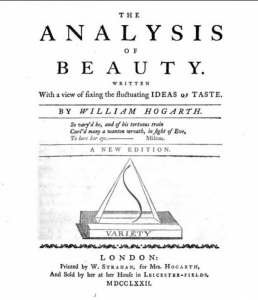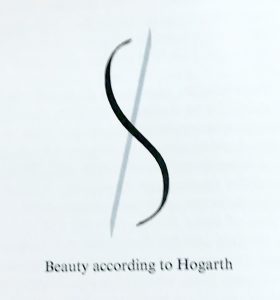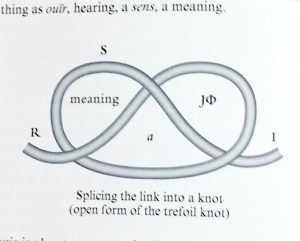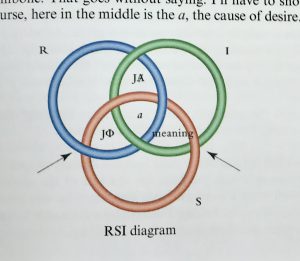SINTHOME/Theopraxesis
Jacques Lacan, The Sinthome, Seminar XXIII, 1975-76
Lacan offered seminars annually from 1952 to 1980. Lacan’s seminars make an important contribution to the Theory in the CATTt guiding the invention of Konsult in general, and theopraxesis in particular. In this later seminar Lacan makes explicit some connections with the sources of our project that until now operated as assumptions. The first of these relationships is outlined here.
Capabilities.
Real, imaginary, and symbolic strikes me as just as valid as the other triad from which, going by Aristotle, the juice was extracted to compose man, namely, will, intelligence, and affectivity. (Sinthome 126).
As discussed in the book, Konsult: Theopraxesis, one function of our experiment is to support a transition from literacy to electracy in education (to negotiate a passage from one apparatus to another). The pedagogy is centered on egents, the ones supposed to learn, appropriating the resources of Arts & Letters curriculum as means for students to undergo and develop their capabilities—their faculties, powers, virtues, potentiality—identified in the tradition dating from the invention of literacy in the Athenian academies as the embodied intellectual virtues: Theoria, Praxis, Poesis (theory, practice, poetics; thinking, doing, making; understanding, will, imagination). Kant’s Three Critiques take up this thread. The Third Critique promotes Aesthetics to equal status with Science and Morality, to propose aesthetic judgment as mediator bridging the abyss separating science and religion. Hannah Arendt took up Kant’s project as the best option for a Public Sphere in industrialized mass society after Auschwitz.
The importance of Lacan’s contribution is apparent in this context. His mnemonic image of the embodied virtues is a bag (the body, mathematically the empty set, the one) tied closed with cord (string, ficelles). RSI (playing on rhymes and puns with “heresy” and “airesis” or choice)—Lacan’s updating of the three faculties—Real, Symbolic, Imaginary—interrelate topologically, entangled in a way that Lacan explores through knot topology, with the Borromean knot specifically manifesting the sinthome (unique symptom). We have argued elsewhere that the sinthome helps account for the image of wide scope. One implication to be tested in our experiments is that in experience we encounter the apparatus stack (the popcycle) as entangled, knotted, in a manner articulated by topology. Lacan supplies one guide for the Kant-Arendt project, that we are calling theopraxesis: the virtues and their institutions already are fully integrated in a potential state (dunamis, but in a condition of privation, steresis). The “symptom” of this virtual condition is the polemos or seemingly irreducible conflict apparent in relations both macrocosmic and microcosmic of civilization.
HOGARTH: Line of Beauty
 A second affiliation with tradition important to note in this seminar is Lacan’s reference to Hogarth’s curved line of beauty as relevant to the genealogy of his knot topology. This connection makes explicit Lacan’s contribution to the larger question of the gramme, the invention of the plasmatic line in the Paleo apparatus, in continuing service up to the present, now augmented in electracy through animation and digital FX. Sergei Eisenstein cited Disney’s animated film, Steamboat Willie (1928) as a revelation of the new order opened up in media by the plasmatic line. We will have more to say about the ontological properties of this line.
A second affiliation with tradition important to note in this seminar is Lacan’s reference to Hogarth’s curved line of beauty as relevant to the genealogy of his knot topology. This connection makes explicit Lacan’s contribution to the larger question of the gramme, the invention of the plasmatic line in the Paleo apparatus, in continuing service up to the present, now augmented in electracy through animation and digital FX. Sergei Eisenstein cited Disney’s animated film, Steamboat Willie (1928) as a revelation of the new order opened up in media by the plasmatic line. We will have more to say about the ontological properties of this line.




